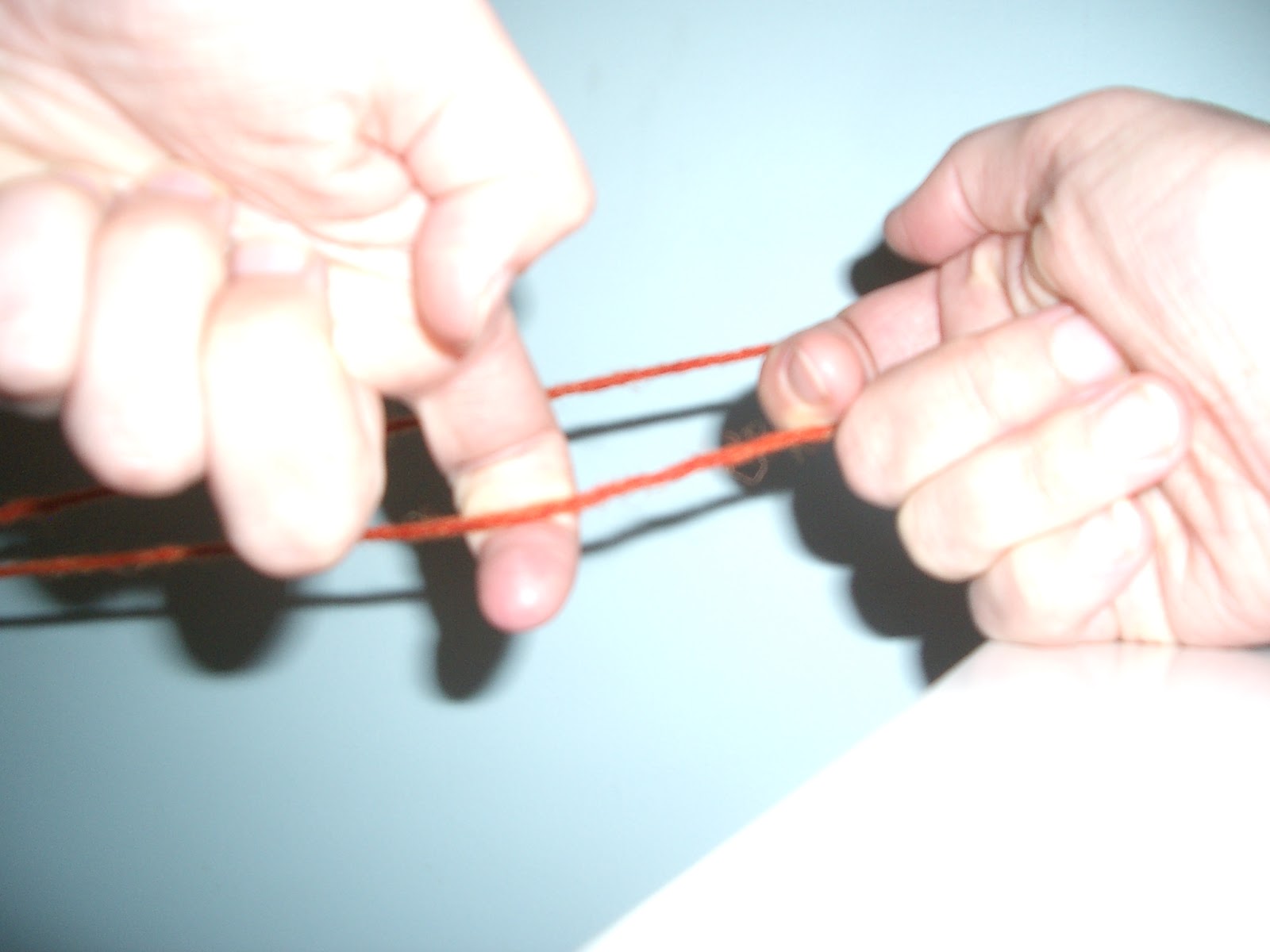Having established what reversed and unreversed are in fingerloop braiding, there is some more complex terminology and concepts that I'd like to make you aware of that can help us better communicate about fingerloop braiding.
Why loop manipulation?
Why do we sometimes call fingerloop braiding "loop manipulation"? Well, the loop is an essential part of the technique that tells it apart from plain braiding or fingerweaving. The string needs to pass through a loop to create a fingerloop braid, instead of just pass over another loop as in a conventional braid. It is possible to do a plain braid using loops: the end product just loops like you were plaiting with two strands of string held together.I still haven't answered why we call it loop manipulation rather than fingerloop braiding - well that is because while the loops are essential, using fingers to manipulate them is not. One Japanese method of loop manipulation uses loops held over the hands instead of over individual fingers.
Orthodox or unorthodox?
An unorthodox fingerloop braid pattern reaches over (rather than through) some loops to pick up others. That is it employs the sort of move normally done in conventional plaiting in fingerloop, rather than the fingerloop move of passing a loop through another loop.This concept is explained more fully at LMBRIC and by Ingrid Crickmore.Unorthodox patterns are not normally used in hand held methods as it is much more difficult to achieve when fingers are not used. But in finger held methods, unorthodox braids can be quite easy to make, in fact the broad lace of 5 bowes which is often the first fingerloop braid most people learn is actually an unorthodox pattern. This braid skips the lowest finger of the active hand (an unorthodox move), while the square "pursestring" is orthodox as the loops pass through all the fingers on one hand before picking up a loop from the other hand. If you've wondered why these two very similar braids have quite different profiles, this difference between orthodox and unorthodox explains it.
Warp twining (transfer move)
Most of our braids are simple through the loop fingerloop patterns, but there are a number of patterns where things work differently. Any patterns with an exchange/transfer move can be called "warp twining". A 4 loop spiral is the simplest twining pattern and was used historically.I like to think of warp twining and more conventional fingerloop as different families of fingerloop. The warp twining family works best with even numbers of loops as you can swap the loops with each other in pairs, it doesn't just have simple members like the 4,6 and 8 loop spirals, but also has more complex combinations such as the green dorge and it's variants and the lace maskel.
The conventional fingerloop family generally works best with odd numbers (eg braids with 3, 5 or 7 loops) because where a simple pattern is used, it is simple to always know to pick up a loop from the side with the most loops, and one can maximise the number of loops on your fingers. I have done a simple conventional fingerloop of 4 loops in the manner of the simple 3 loop braid, and it works fine, but is much more confusing to do than the same pattern using 5 loops. Once conventional fingerloop patterns are complex enough, the guideline about odd numbers of loops tends to break down a little more.
Of course, just to make things more interesting, some braids combine both conventional fingerloop and warp twining.
Hand position and operator finger:
There are also a number of different ways you can hold your hands when doing fingerloop. The most common is "V-fell" or "A-fell" which is the difference between weather loops cross between hands at the top or bottom of your hands. This also means the "operator finger" (the finger which picks up loops) will change from your top (index) finger to your bottom (little) finger.This concept is explained well, with more photos by Ingrid Crickmore who also talks about Slentre, an even rare way of holding your hands and transferring loops. The difference between A and V-fell are illustrated more in this video.
The A-shaped fell (method 1) is the dominant European medieval method. The V-fell (method 2), is mainly known in the east, but isolated examples exist in traditional Finnish braiding. This link from LMBRIC newsletter 11 has nice images of the finish method, see also LMBRIC newsletter 6 for an earlier report of this method in use in Finland.










